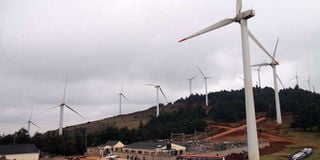Plan to step up power plants makes notable strides

The Ngong wind power farm in Kajiado County under construction, on July 24, 2014. Last week, Kenya Electricity Generating Company (KenGen) said it will spend Sh166 billion in the next two years to set up wind and geothermal power plants with a combined capacity of 460MW. PHOTO | SALATON NJAU | NATION MEDIA GROUP
What you need to know:
- Currently, the countries installed capacity for power generation is about 2,200MW, built on various sources since independence.
- Construction of a 300MW wind power plant in Marsabit kicked off this year. Last week, KenGen said it will spend Sh166 billion in the next two years to set up wind and geothermal power plants with a combined capacity of 460MW.
- Experts say introduction of incentives to attract foreign investors could promote industrialisation and guarantee effective consumption of the planned additional electricity.
The Kenya Electricity Generating Company (KenGen) has been putting up new plants to increase capacity to generate power by 5,000 megawatts by the end of 2016.
The plan, launched in 2013, has highlighted the role of private investors in power generation from renewable sources.
This has seen an increase in the appetite for joint ventures and deals in the power sector.
But little was said about how this new capacity would be utilised to avert extra costs on consumers for idle generators.
Experts have raised questions on the ability of the economy to absorb all the planned capacity.
It has emerged that consumers could pay as much as Sh50 billion annually in capacity charges.
“The government predicts a growth in demand for electricity of between 11 and 12 per cent every year. However, in the last seven years, annual demand for power has grown by an average 6 per cent,” said Mr Hindpal Jabbal, an energy analyst and former chairman of the Energy Regulatory Commission (ERC).
“During the next 15 years, this demand is expected to grow by 8 per cent which is still below the government’s target of 15 per cent.”
Currently, the countries installed capacity for power generation is about 2,200MW, built on various sources since independence.
Most of the additional capacity is set to come from geothermal, wind and coal.
Construction of a 300MW wind power plant in Marsabit kicked off this year while KenGen is currently carrying out feasibility studies for establishment of a 100mw wind plant in Meru County.
A PROMISING FUTURE
Amu Power Limited, a consortium of Gulf Energy and Centum Investments, is constructing a Sh174 billion coal-fired power plant in Lamu that is expected to add 960MW to the grid upon completion.
Last week, KenGen said it will spend Sh166 billion in the next two years to set up wind and geothermal power plants with a combined capacity of 460MW.
The ability to consume 5,000MW is pegged on mainly growth in industries, which use much power compared to households.
Nairobi, which has the highest concentration of industries, accounts for nearly half of electricity consumed locally.
In the past year, Kenya Power has launched an online portal for use by industries to submit applications for power connections.
The portal is expected to fasten the process of power connection to industries in the search for a market for the additional electricity.
KenGen is in the process of setting up an industrial park at its Olkaria geothermal site to woo investors who will then use the extra power.
Last October, the company advertised for a consultant to carry out a feasibility study for the park.
It is said that the state-owned power generator is considering selling electricity directly from its plants to the industries, a move that is aimed at reducing connection time as it eliminates other intermediaries.
According to the latest edition of World Bank’s Ease of Doing Business report that measures countries’ competitiveness for investment, Kenya rose to position 108 from 129.
ENCOURAGE INVESTORS
Experts say introduction of incentives to attract foreign investors could promote industrialisation and guarantee effective consumption of the planned additional electricity.
“The government needs to take the step to encourage industrialisation by setting up efficient transport and logistics infrastructure. It can also consider introducing cheaper tariffs for manufacturers operating during off-peak hours,” said Mr Isaac Otolo, an associate director at PricewaterhouseCoopers (PWC).
Kenya Power currently applies a standardised tariff for industrial customers that does not consider their hours of operation.
During the year, the Ministry of Energy and Kenya Power have held talks with the Kenya Association of Manufacturers and the issue of high cost of energy has often come up.
Industries account for 60 per cent of Kenya Power’s total customers.
Sales to industrial customers increased by 5.5 per cent last year, according to the company’s financial results for the year to June 30, 2015.




